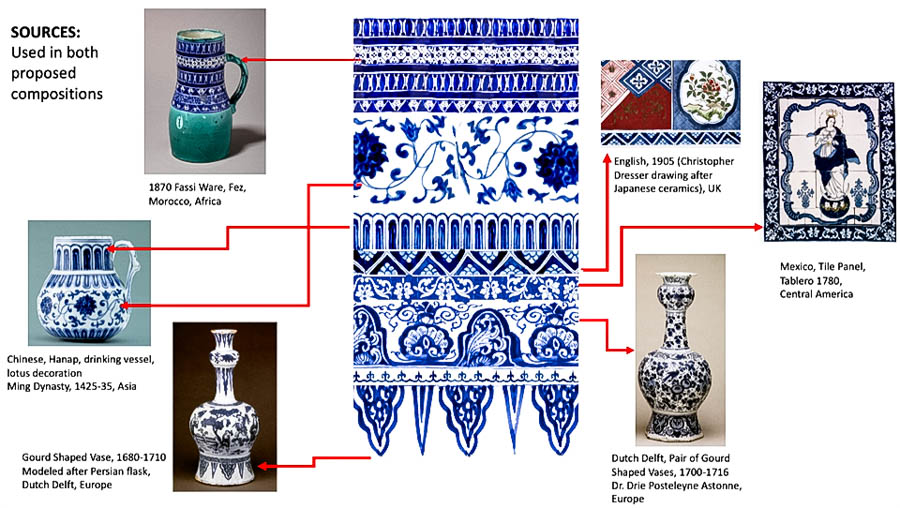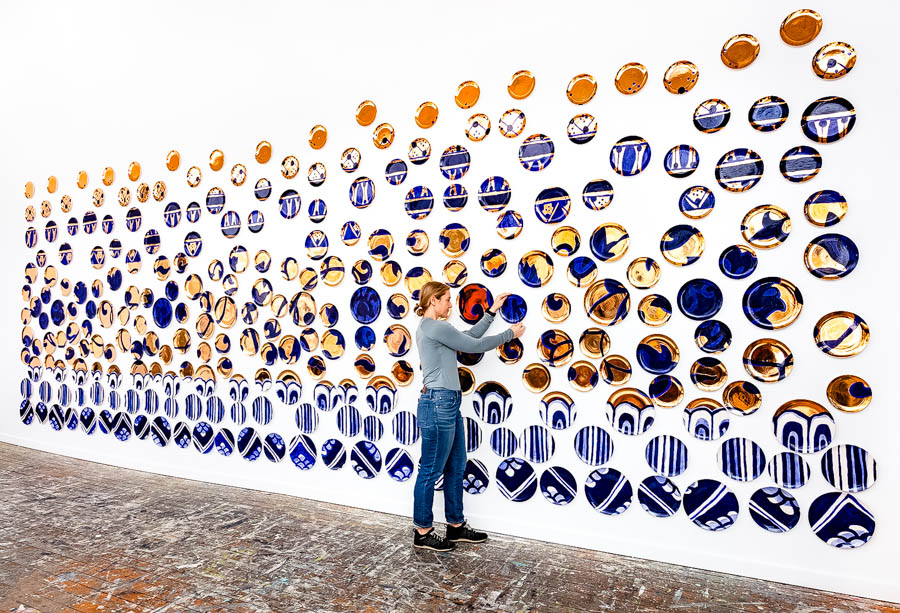When you think about ceramics, what comes to mind? A colorful tiled fountain in a Spanish plaza? Intricately patterned plates in your grandmother’s china cabinet? Or maybe your favorite mug, the one that’s been by your side through every move, illness and morning coffee? For Ceramic Artist and Designer Molly Hatch, the objects with which we live our lives are not just functional tools but are essential pieces in the puzzle of our collective humanity.
Raised on an organic dairy farm in Vermont, Hatch became acquainted with antique decorative objects passed down in her family. “All these objects around me were more aesthetically influential than you might think because they were objects in part that represented a family history and wealth that I didn’t understand but had access to through the objects that I was surrounded with. They were all tired and had been repaired by family members over the years and were no longer valuable per se. Oriental rugs had been hand-painted; they’d been worn out,” she says. The work of her grandmother and mother, who were both painters, and a childhood visit to a family friend who was a potter introduced a young Hatch to a career in art, in which she explores the role of such objects across history. “I remember thinking it was pretty magical,” Hatch adds, reflecting on that visit. “It was the first time I understood that from a design perspective, there are designers, there are people behind objects that we live with every day. Seeing someone make a bowl and seeing that connection—that it’s dirt literally being shaped into a bowl and that you’re eating out of it on a day-to-day basis—completely changed my understanding of what was possible with raw materials.”

After her early introduction to the art world, Hatch earned a Bachelor of Fine Arts from the School of The Museum of Fine Arts Boston at Tufts University and a Master of Fine Arts in Ceramics from the University of Colorado at Boulder. While her coursework focused on drawing and painting, she attended non-major ceramic classes in her free time as an undergraduate. “I started doing drawings and paintings on these functional pieces. It’s the same imagery, concept, thinking and approach, but just removing it and putting it onto something that you would hold, touch, eat or drink from completely changed how I felt people were able to interact with the work or give permission to the viewer to see it in a different way. It activated the artwork. It was exciting because I had a new way to offer an entry point into the same thinking that might be more easily accessible to people than if you were to just look at it as a drawing or painting on its own,” she says.
Over the last 25 years, Hatch has approached her work from this angle. She spent 15 years collaborating with retailers like Anthropologie, creating mugs and vases with delightful illustrations and inspiring sayings. Alongside this design work, she has created ceramic installations for clients like the High Museum of Art in Atlanta, Georgia, and the Tiffany & Co. New York Landmark store. She’s even published a book, entitled A Passion for China: A Little Book About the Objects We Eat From, Live With and Love, in which she does a deep dive into the history of the ceramic creations that inspired her and are beloved by others. Last month, Hatch presented her new work, Amalgam, at the Sarasota Art Museum and spoke about the medium’s universal appeal.

While most of Hatch’s museum installations draw inspiration from their permanent collections, the Sarasota Art Museum is a non-collecting institution. “I had this new exciting carte blanche opportunity to decide what I wanted to reflect in the work and truly wanted to present a piece of artwork that showed how multicultural our heritage is in the blue and white tradition,” she adds. The recipient of a scholarship that granted her the chance to travel around Europe and study its artwork, Hatch is fascinated by ceramic’s ability to connect with people across time and space.
“We all have a sense that there’s a preciousness or value in your grandmother’s china cabinet. There was a reverence for objects that was taught to me and is taught to others, like ‘Don’t you want this? This is grandma’s china; shouldn’t you hang onto this?’ Objects carry stories; they’re gifted at the start of someone’s marriage or life, and they often go with us and witness our day-to-day trials and tribunes. Even the most quotidian objects that we live with and surround ourselves with are there along with the story,” Hatch says. “Like listening to a song that reminds you of someone or smelling a perfume or your favorite t-shirt, we have favorite mugs and favorite plates; we have artwork that is a witness and we view it with the sentiment and value that we attach to it aside from the societal assigned value.” With Amalgam, she sought to examine the blue and white motif ubiquitous in ceramic work across the globe, from vases made in China during the Ming Dynasty to tiles produced in Mexico in the late 1700s.
Amalgam, a massive installation spanning both two stories and ceiling space, features blue, white and golden plates dispersed at the top and bottom, but consolidated in the middle. “Blue and white is a rich place to go in the history of ceramics and also in our global history of trade, commerce and shared imagery across cultures,” adds Hatch. In the piece, she deconstructed the patterns on items from China, Morocco, the Netherlands, the United Kingdom and Mexico and reinterpreted them as paintings on plates. “Most of the blue and white wares that we’re familiar with were imported by European merchants as export wares from China,” she says, explaining that until there was a source of porcelain in Europe, many European manufacturers recreated the appearance of these imported products. “Our value of blue and white and what it represents is this extreme wealth. It’s almost like the diamond of the ceramic world, but we’ve lost sight of that because it’s become such a common and cheap material since then,” she adds. “The original objects that were sent to us weren’t even made for Chinese audiences. They are Chinese interpretations of what they thought Europeans would want. There’s something interesting and rich in it belonging to everyone right from the get-go and belonging to no one at the same time.”

Through all her works, Hatch describes herself as “going to history with an eye to interrupting it.” She is searching for her place as a contemporary female artist in the medium’s storied past. “I feel like I’m adding to a conversation and not necessarily wanting to make something new; I want to add my two cents to this long story. What comes to light more recently is being inspired by other women who are thinking about how we exist in the art world as women—or don’t exist, and understanding that a lot of what I’ve been doing is saying ‘I belong here in this story of art.’ Typically, history records the male story, so by appropriating, reinterpreting, re-presenting, breaking those images down and abstracting them by putting them on plates, I’m re-presenting them to you but from a contemporary feminist perspective,” she says.
Amalgam encourages museum visitors to consider their relationships with these objects, prompting them to see themselves culturally and literally reflected in the gold of the work. “Some hard conversations can come up with that too,” Hatch adds. “Who does it belong to? What is its heritage? How do we honor where it came from, how it got to us in our different cultures and what does that mean to each of us? Because ceramics doesn’t change, you can see the brushstrokes, you can see a thumbprint in a glaze and you can see a connection to the maker. Even if it’s 200 years old, it’s as fresh as the day it came out of the kiln. There’s an intrinsic connection to our cultural history, no matter what the surface looks like.”
Hatch aims for the installation to spark conversation about “cultural trade, information passing through generations and artisans and people reinterpreting the reinterpreted, like a telephone game of blue and white.” Every viewer will have a unique experience with the piece because the colors and motifs it features mean something different to everyone. “Ultimately, we’re all connected and we’re all interested in the same thing, and it’s sort of a leveling of the playing ground,” she says. “It’s an exciting conversation to have, and the fact that it can just come from something as simple as a cup that you’re drinking out of is particularly exciting.”









